Introduction to the Development of Full-Chain Games in 2023
There have been significant advancements in full-chain games in 2023, attracting increasing attention. We believe this is due to the following reasons:
- Jump Crypto clarified the connotation and extension of the concept of full-chain games at the beginning of the year, making a clear distinction between full-chain games and the GameFi sub-track of blockchain games.
- The ECS architecture game engine began to emerge at the beginning of the year, making it more convenient to build complex applications on the chain.
- The emergence of Ticking Chain has made a qualitative leap in the logical frame refresh rate of full-chain games, expanding the types of full-chain games from turn-based to real-time strategy games requiring high refresh rates.
- AA wallets began to be popularized in 2023, greatly improving the operational experience of full-chain games, eliminating the need for signing authorization for each on-chain operation.
- With the widespread adoption of ZK-Rollup, ZK technology has seen rapid development, helping full-chain games expand from creating information-symmetric games to "asymmetric information games."
- The narrative of Autonomous Worlds began to permeate from the geek community to the VC community, mainly due to two major industry events: the "Autonomous Worlds Hackathon" online hackathon hosted by ETHGlobal, 0xPARC, and Lattice in May, and the "Autonomous Worlds Assembly" offline conference held in Istanbul in November.
- Over a dozen full-chain games entered the test network stage in 2023, demonstrating preliminary playability.
- In 2023, blockchain infrastructure became increasingly convoluted in Layer2, with the application layer, such as finance and social networking, lacking sufficient innovation. Therefore, the "Crypto Native" full-chain game track became the leader in the application layer narrative.
The following will elaborate on infrastructure, narrative logic, full-chain games, industry financing, and other aspects.
Infrastructure
We believe that the infrastructure of full-chain games consists of game engines, Ticking Chain, information hiding systems based on ZKP, and AA accounts.

Game Engine
A game engine is a software framework used to develop and create electronic games. It includes many core functions required for game development. For traditional Web2 games, it generally includes rendering engines, audio processing, physics simulation, and animation systems. By using a game engine, developers can focus on game design and creativity without having to build the entire technical infrastructure from scratch. Game engines provide a fast and effective tool for developers to reduce development costs and time.
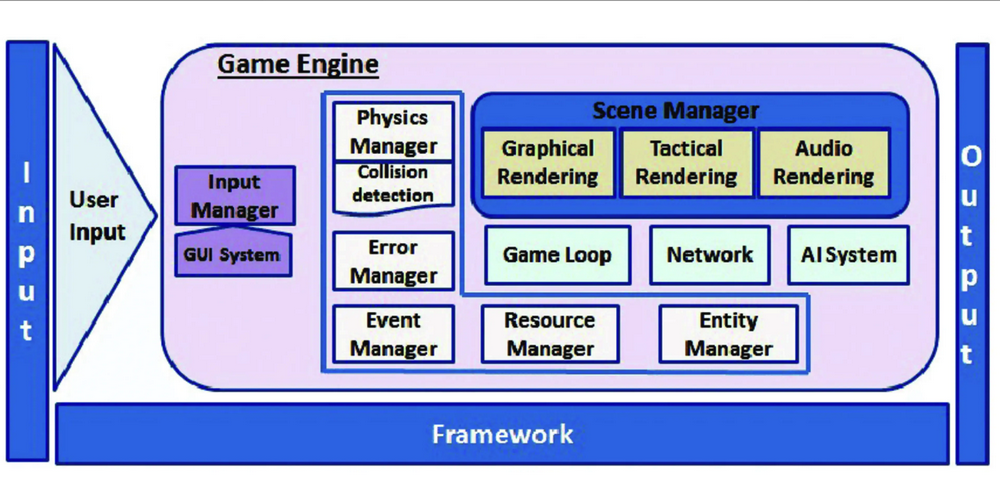
For full-chain games, a tool that can help developers quickly deploy game logic is also needed. This not only shortens the development cycle but also provides a unified data standard for subsequent iterative development and interoperability in the open ecosystem. If we consider the blockchain system as a distributed database, efficiently storing and retrieving game data in this distributed database, building large-scale smart contracts, and synchronizing with front-end states in a timely manner are not easy tasks. The ECS architecture full-chain game engine has emerged.
ECS (Entity-Component-System) is essentially a way of modeling data structures, with its core lying in how to store and organize data.
- Entity: In the ECS pattern, an entity is an abstract concept that does not directly hold data but associates data through components. An entity can be seen as a container for one or more components, primarily providing a unique identifier for components.
- Component: A component is the carrier of data. In the ECS pattern, all data is encapsulated in components. Each component represents a specific attribute or behavior, such as position, velocity, color, etc. Components only contain data and do not include any logic or behavior.
- System: A system is where data processing occurs. Systems determine how to process these entities based on their components. Each system has one or more specific tasks, such as rendering, physics simulation, AI logic, etc.
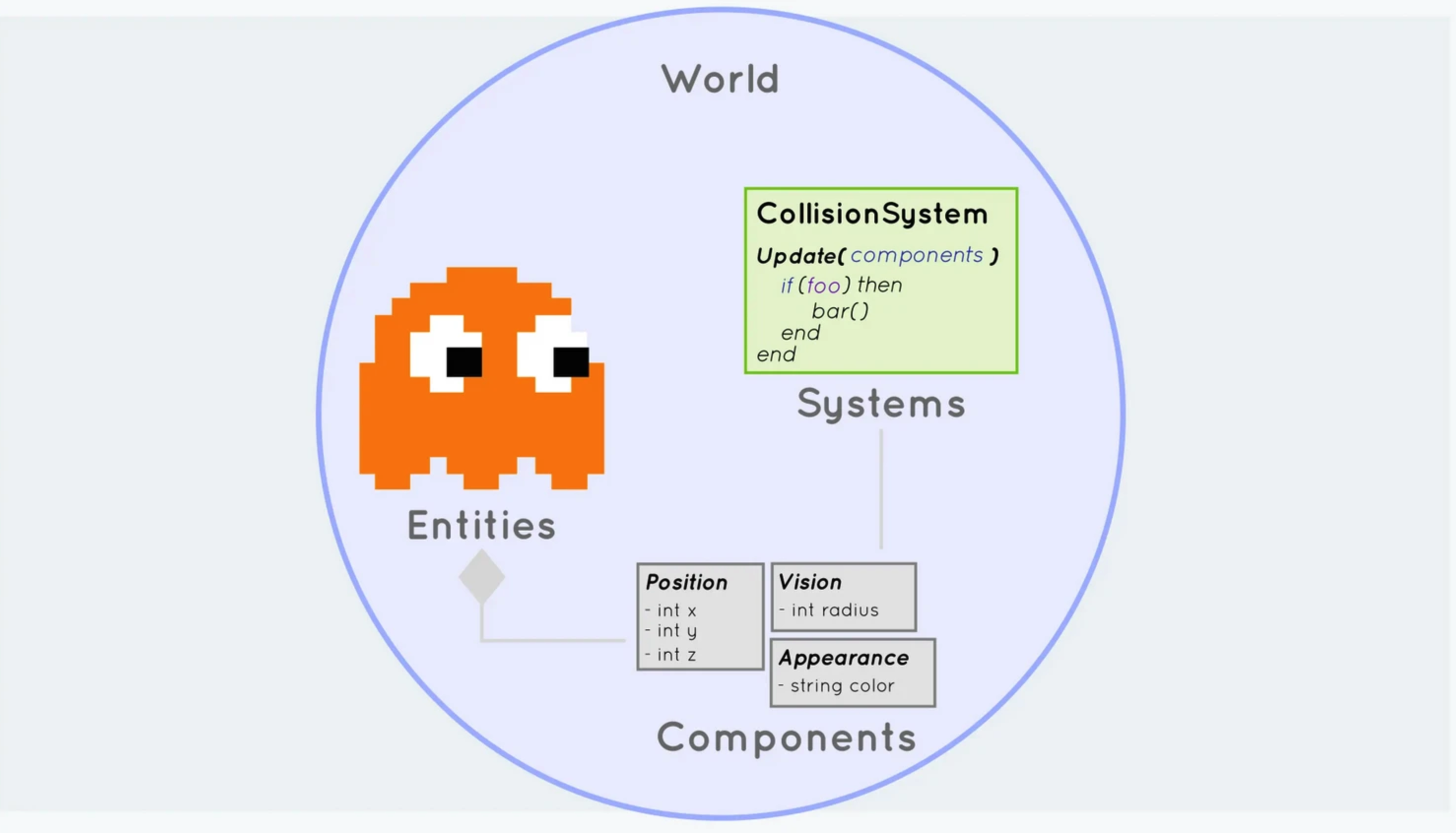
It separates data (components) and behavior (systems), making data storage and processing more flexible and efficient. The advantages of this architecture are:
- Composability: By combining different components, entities with various properties and behaviors can be created without the need to create a large number of classes or structures.
- Data Locality: Because components only contain data, related data can be tightly stored together, improving cache utilization and thus performance.
- Reusability: Systems only care about data, not which entity the data comes from, so the same system can be reused among multiple entities.
- Parallelism: The separation of data and behavior makes it easier to process data in parallel in a multi-threaded environment.
Although Jump Crypto (@jump_) also proposed an ARC (Action Registry Core) architecture game engine, we believe that this architecture is merely a variant of the ECS architecture and has many limitations. Therefore, the existing full-chain game engine architectures currently all adopt the ECS architecture.
MUD: Lattice (@latticexyz)'s MUD is the oldest and most famous full-chain game engine in the Web3 field. In the first-generation version, it was clearly stated that MUDv1 was based on ECS. In the middle of the year, Lattice announced the V2 version, making significant changes to the overall architecture of MUD. MUDv2 includes: Store (an on-chain database), World (an entry point framework providing standardized access control, upgrades, and modules), rapid development tools based on Foundry, client data storage reflecting on-chain states, and MODE (a Postgres database that can use SQL queries and reflect your on-chain state). At the end of the year, MUD introduced its own separate Layer2 rollup (based on OP Stack), named Red Stone. Currently, MUD is only compatible with EVM-compatible chains.
Dojo: In addition to being written in Solidity, StarkNet's Cairo is also a commonly used language in full-chain games. However, MUD does not integrate well with Cairo. Therefore, the founders of two active projects in the StarkNet ecosystem, Realms and Briq, forked MUD and jointly developed the full-chain engine Dojo (@ohayo_dojo) based on Cairo.
World Engine: Argus (@ArgusLabs_) has designed a sharded Rollup framework specifically for full-chain games. The World Engine consists of two key parts. The first part is the core, which consists of two key elements: the EVM Base Shard, a sharded hybrid execution layer and sorter, and the Game Shard, a high-performance game engine with an execution layer. In addition, there are some peripheral components, such as transaction relays and network code for client-server communication, and a ZK Cloud prover for ZK games like Dark Forest. In short, the World Engine also adopts the ECS architecture, comes with an EVM-compatible Layer2 chain, and the chain can achieve efficient automatic "logical frame" refresh.
Keystone: Curio (@0xcurio) open-sourced Keystone in May, a Layer2 chain with a built-in game tick and ECS full-chain game engine, based on OP Stack. This design allows all ECS operations (such as queries and state settings) to have faster performance compared to ECS state written through smart contracts. Smart contracts can access the underlying ECS chain state through custom precompilation. Game logic can be written in Go language instead of Solidity, enabling large-scale parallelization.
Other chains have also seen the emergence of different full-chain game engines based on the ECS architecture, such as Obelisk (@0xObeliskLabs) based on the MOVE language, and BOLT (@magicblock) based on Solana, and so on.
Ticking Chain
Traditional games are loop-based, as their core operating mechanism is the game loop. The game loop is a continuously repeating process, usually involving handling user input, updating game state, and rendering the game world. This loop continues during game runtime, typically running tens to hundreds of times per second to maintain the smoothness of the game world. In this architecture, game systems (such as physics engines, AI systems, etc.) check and process the game entities and components they are concerned with in each loop.
However, blockchain architecture is push-based. Blockchain is a distributed database that shares and stores information through nodes in the network. When a node generates a new transaction (such as a transfer or contract call), the transaction is pushed to the network, and other nodes in the network receive and verify the transaction before adding it to the blockchain. This is a passive process, as nodes do not actively seek out new transactions but wait for other nodes in the network to send new transactions. Therefore, blockchain architecture is referred to as push-based.
In traditional Web2 games, the execution of the game loop function is also called the "logical frame," which can be integrated into the game backend server or set as a "heartbeat server." In full-chain games, the synchronization of logical frames is generally achieved through "lazy update" and "manual ticking" for proactive game loops. The drawback of this approach is that the refresh rate of logical frames is relatively low, resulting in higher gas fees. @therealbytes has achieved efficient and automated synchronization of logical frames by precompiling the loop function into chain nodes.
Representatives in this area are World Engine and Keystone, which have integrated ticking chain functionality into the ECS architecture, thereby significantly increasing the synchronization and refresh rate of logical frames for full-chain games, expanding the range of genres that can be created for full-chain games.
AA Wallet
Because every operation in full-chain games needs to be on-chain, this brings significant inconvenience in usage: it is not feasible to require users to sign and authorize every transaction. The previous solution to this problem was to use a "Burner Wallet."
A Burner Wallet is a temporary wallet that is generated when a user visits a game website, with the private key stored in the local browser cache and automatically authorizing every transaction. This can only be seen as a temporary solution, as the account will permanently disappear if the user refreshes the browser cache. Additionally, it lacks sufficient security and privacy.
The emergence of AA abstract wallets has completely solved this problem. Currently, there are two types of accounts on Ethereum: externally owned accounts (EOA), usually referred to as wallet accounts, consisting of a private key and a public key, which require the user to authorize and pay gas for each transaction. The other type is smart contract accounts, where various DApps deployed on Ethereum operate in the form of smart contracts.
There are two routes for account abstraction: the compatible 4337 scheme and the native account abstraction scheme. Currently, Arbitrum, Polygon, Optimism, and BNB do not have native integrated account abstraction. Instead, they are more supported through 4337-related products (such as Biconomy, Stackup, etc.), with infrastructure still being built. In contrast, Starknet and zkSync support native account abstraction.
AA wallets can integrate Session keys into Paymaster, allowing users to pre-approve transactions for a full-chain game based on a set of parameters, such as a given duration, maximum gas, maximum token volume for a specific token, or a specific function of a specific contract. This allows for uninterrupted gameplay without the need for signing and confirmation for each operation, making it user-friendly.
Another development is ERC-6551, which provides a smart contract account for all ERC-721 tokens. These accounts not only allow ERC-721 tokens to hold various assets such as ERC-20, ERC-721, ERC-1155, etc., but also enable ERC-721 tokens to interact with various applications. In the field of full-chain games, this enables the simultaneous transfer of game assets and game IDs.
ZKP-Based On-Chain Information Hiding
"Fog of War" is a common mechanism in games, with typical examples including "StarCraft" and "Warcraft III." This design hides information by covering certain areas of the game map, which only become visible when players explore those areas. This mechanism increases the unpredictability of the game environment and is a typical feature of incomplete information games. Most popular MMO games use incomplete information game mechanisms, providing players with more space for exploration and strategic planning.
However, in blockchain technology, data is usually completely public and transparent, making it difficult to implement incomplete information mechanisms. However, the Dark Forest game successfully maintains its privacy status while requiring players to publicly submit verifiable valid actions by using zero-knowledge proof technology zkSNARKs. This allows Dark Forest to create an incomplete information game environment on the blockchain.
However, this complex information hiding method requires customized ZK circuit programming, making widespread information hiding impossible in full-chain games. This is why almost all full-chain games in development in 2023 do not have "fog of war." The market still needs a general-purpose ZK circuit that can achieve the "fog of war" function. Several teams are attempting to address this challenge, such as Zypher Games (@Zypher_Games), which has launched the zk-Game SDK. It achieves high-performance, low-cost decentralized shuffling through optimized wasm and precompiled contracts. Its on-chain randomness no longer requires traditional VRF, enabling decentralized fair shuffling and gaming. It also introduces the zero-knowledge game engine UZKGE, with a highly optimized Plonk library, serving as a fast-expanding zero-knowledge (ZK) circuit library to meet the diverse needs of game developers. These circuits facilitate complex calculations, ensure the integrity of game mechanisms, and protect player privacy, allowing game developers to verify critical game data without revealing potential details.
In October, Flynn Calcutt from 0xPARC published an article titled "ZK Hunt: an exploration into the unknown," introducing how the "Commitment" method and ZK circuits, combined with token penalties, can be used to achieve various on-chain information hiding methods, providing a new approach for creating asymmetric information in full-chain games.
Narrative Logic
In January, Shanav K Mehta and Dev Bharel from Jumpy Crypto published a series of articles titled "Gaming Infrastructure," proposing the classification of on-chain games, the specific definition of full-chain games, the benefits of creating full-chain games, and the ARC-based full-chain game engine architecture. With this, full-chain games became a defined track.
We now know that a simple definition is as follows:
A fully on-chain game refers to: all game logic, states (assets and others), are on-chain, implemented through smart contracts. Sometimes, we also use the term "on-chain game" to refer to this. In the literature of on-chain games, we often see terms like "Autonomous World" or equivalent "On-Chain Reality."
However, the term "full-chain game" is more of a technical discussion. The more popular narrative at the moment is "Autonomous World," originating from Ludens of Lattic, who wrote a short paper in 2022 titled "Autonomous Worlds."
In the article, Ludens believes that an autonomous world is a "world with a blockchain-based foundation," meaning it has strict narrative boundaries and formalized introduction rules, and does not require privileged individuals to maintain its existence.
This statement describes the three core characteristics of "Autonomous World":
- Strict (Hard) Narrative Boundaries: This means that the world has a fixed and immutable set of baseline rules. They do not change over time or circumstances, providing stability to the world.
- Formalized Introduction Rules: This indicates that there are clear and fixed rules for entering and participating in this world. These rules include how to become part of this world and how to interact within it.
- Does Not Require Privileged Individuals to Maintain Its Existence: This world is self-sustaining and does not rely on any specific individual or organization to maintain or manage it.
In the concept of Autonomous World, the world does not specifically refer to a place where human life exists, but rather a container, a place that contains rules and narratives. Strictly speaking, the concepts of full-chain games and autonomous worlds are not completely equivalent. All autonomous worlds are full-chain games, but not all full-chain games are autonomous worlds. When a full-chain game can expand without permission, it becomes an autonomous world.
In addition to the narrative of autonomous worlds, there is another simpler narrative to understand: full-chain games are actually a form of "Decentralized Game." This narrative mainly mimics the terminology of decentralized finance (DeFi): if writing financial rules into smart contracts is called "DeFi," then naturally writing game rules into smart contracts is called "DeGame."
Full-Chain Games
In the past year, many full-chain games have entered the testing phase. Although most are still rough, they have completed the initial concept verification, showing a certain level of playability and combinability.
Sky Strife
Sky Strife (@skystrifeHQ) is a fully on-chain real-time strategy game (RTS) built using the MUD engine. It is developed by internal game designers and developers at Lattice. The gameplay of Sky Strife is similar to other real-time strategy games. For example, in a four-player map, each player starts in their main base at one of the four corners of the map. The players' goal is to compete for more resources to produce soldiers and ultimately eliminate other players. Resources in the game are represented as Gold (g). Players can consume Gold in their main base to produce units with different attack power and movement speed.
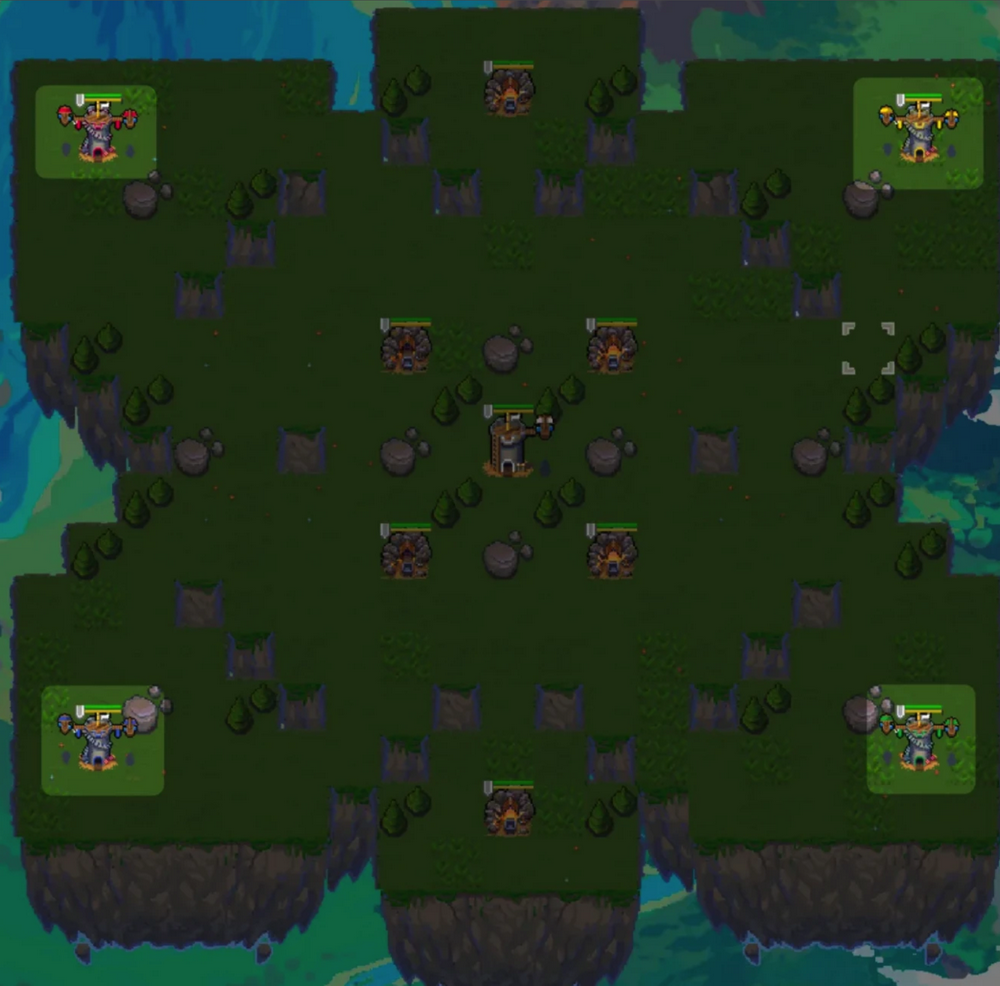
Sky Strife began a new round of public testing for Season 0 in November and used the Redstone, a new Layer 2 scaling solution designed specifically for full-chain games released by Lattice.
Primodium
Primodium (@primodiumgame) is a simulation construction game developed based on the MUD engine, with its mechanics inspired by the famous simulation management game "Factorio." In Primodium, players need to design and build different automated production lines, combining conveyor belts, various factories, and natural resources on the map to create their own automated production buildings on the planet, continuously producing increasingly complex industrial products. Game actions include gathering, transportation, processing, construction, research, and combat. Players need to continuously gather resources, upgrade technology, build weapons, defeat other players, and ultimately dominate the planet.
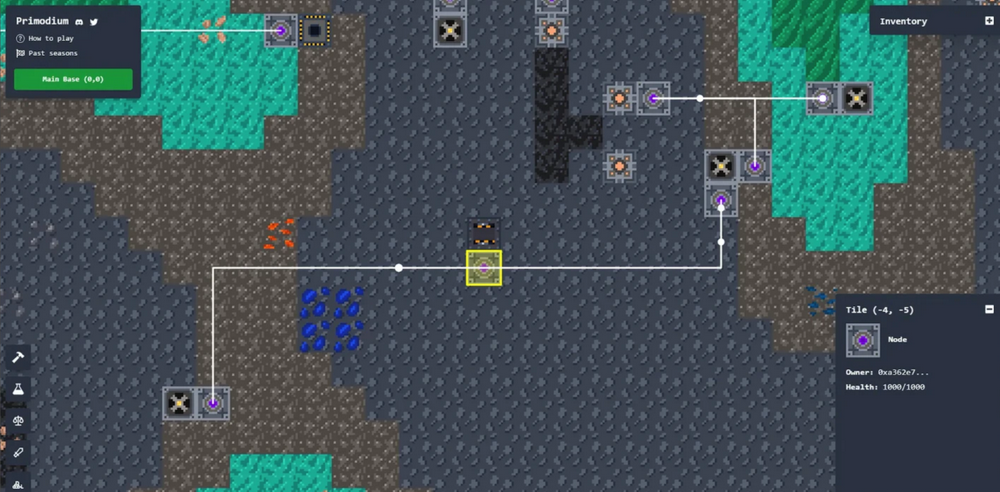
Cellula
Cellula (@cellulalifegame) is a fully on-chain artificial life simulation game. Players can explore, nurture, evolve, and collect unique "life" in the game. In this game, the rules of Conway's Game of Life are considered as the "genetic code" of "life," determining their form and vitality. By using the game's crafting table, players can freely create various genetic sequences and breed their own on-chain "life." These "life" have unique appearances and attributes, showcasing diverse life forms.
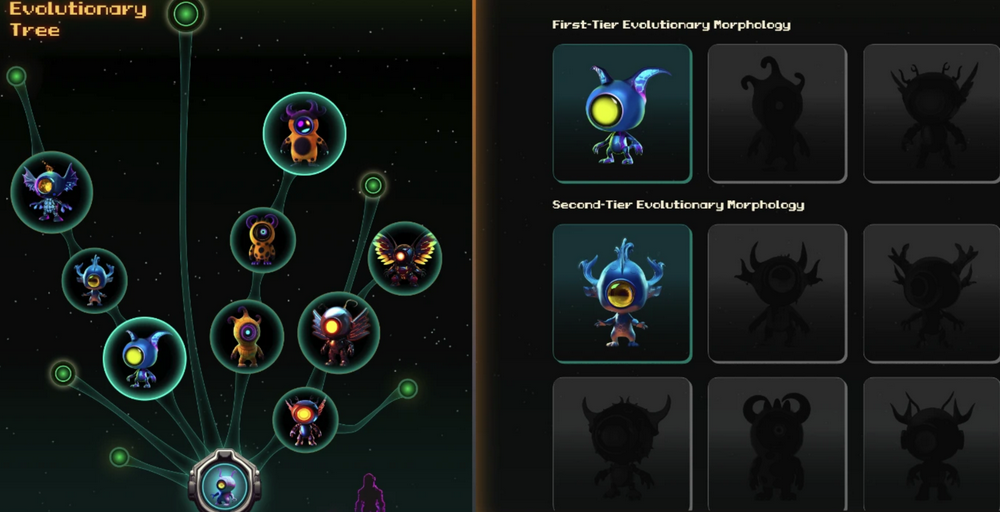
The Ethereum block height serves as "time" in the game, and each "life" will grow and evolve in the Ethereum spacetime ecosystem, just like aquatic creatures gradually adapting to land life and eventually becoming amphibians in the real world. However, the cycle of life is always accompanied by birth and death—when a "life" loses vitality, it will permanently die on-chain, making room for the birth of new "life."
Loot Survivor
Loot Survivor (@LootRealms) is a text-based dungeon adventure game based on Starknet's Dojo, the first game in the Realms autonomous world ecosystem, developed by senior member Loothero of Bibliotheca DAO, using the unique Play2Die mechanism. The game is inspired by the background story and gameplay of the original Loot project community. Players need to fight beasts, clear obstacles, collect equipment for survival, and compete for higher positions on the leaderboard.
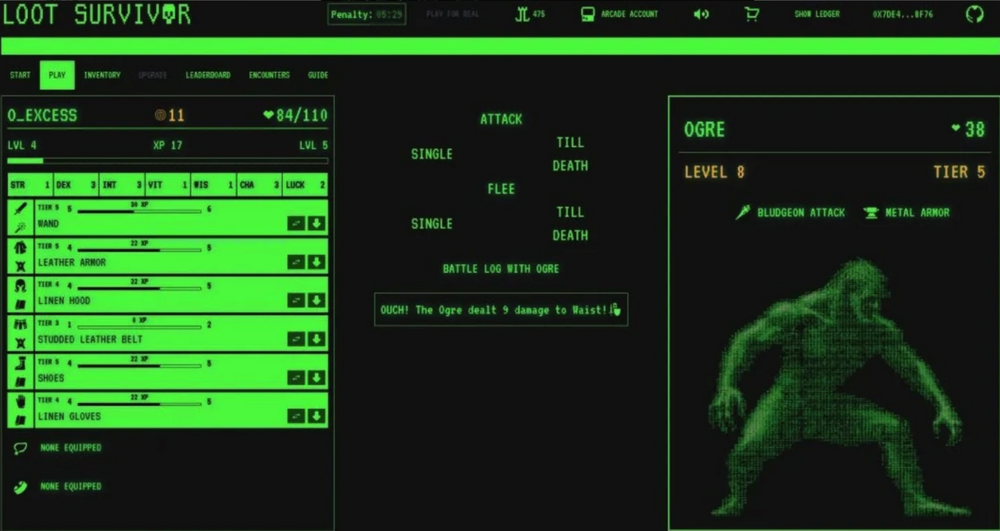
Dark Frontier
Dark Frontier (@DarkFrontierGG) is a remake of the famous full-chain game "Dark Forest," with identical gameplay. In Dark Frontier, each player controls their own planet and needs to gather resources, build bases, and develop technology to enhance their combat capabilities on the planet. Players can use resource production buildings, technology research, and weapon manufacturing facilities to gain an advantage in battles. When flying in interstellar space, players need to continuously scout and explore to discover other planets and resources. When two players simultaneously discover the same planet, they can choose to attack the planet or choose to flee. During an attack, players need to use their weapons to attack the opponent's base and seize their resources.
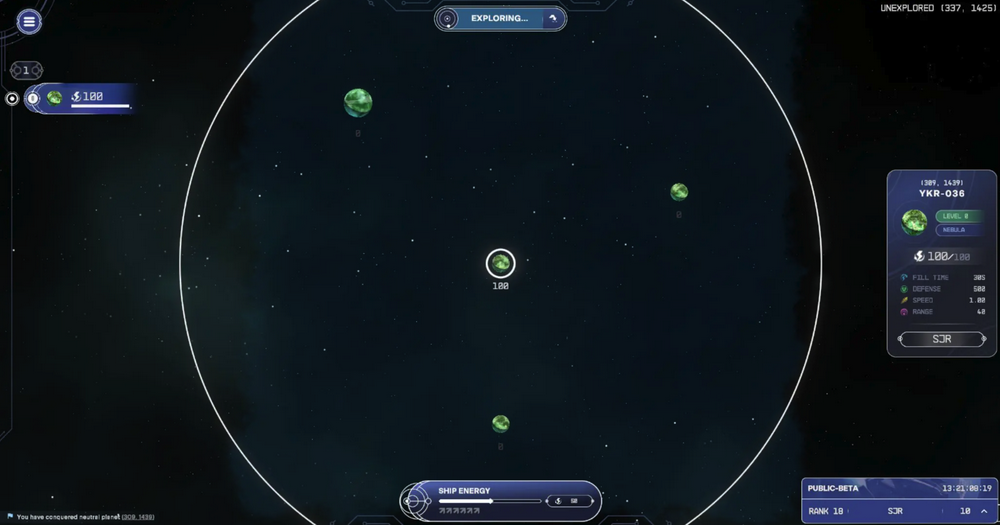
The game was remade by Argus based on the World Engine, with significant improvements in the visual UI compared to the original version, and it began public testing in December.
There are over a dozen other full-chain games in development or in very early testing stages, such as Gabby World, Infuence, Mississippi, Dope Wars, Mithraeum, Word3, PixeLAW, Shaoshin, Pirate Nation, and more, which will not be detailed here.
Industry Financing
As a sub-track of blockchain gaming, full-chain games received limited public financing during the concept verification stage in 2023. Here are some examples:
Game engine Argus Labs completed a $10 million seed round of financing, led by Haun Ventures, with participation from Elad Gil, Balaji Srinivasan, Siqi Chen, Kevin Aluwi, Sunny Agarwal, Calvin Liu, Scott Moore, Robot Ventures, Anagram, and Dispersion Capital.
Game engine Curio Research completed a $2.9 million seed round of financing, led by Bain Capital Crypto, with participation from TCG Crypto, Zonff Partners, Formless Capital, Smrti Lab, Robot Ventures, and several angel investors.
Game engine Paima Studios received a $1.4 million grant from Cardano. The Paima code is available on Github, allowing the creation of on-chain games associated with NFTs, where game states can be linked to NFTs.
Proof of Play, a blockchain game startup founded by Amitt Mahajan, co-founder of FarmVille, completed a $33 million seed round of financing, jointly led by a16z and Greenoaks, with participation from Mercury, Firebase, Zynga, and Alchemy, and individual investors including Ravikant, Balaji Srinivasan, Twitch co-founders Justin Kan and Emmett Shear. Proof of Play aims to create fun and easy-to-use blockchain games. Its first game, "Pirate Nation," a social role-playing game, released a test version in December last year, allowing players to battle, craft, trade, and explore, searching for tokens labeled PGLD.
Full-chain game Citadel announced the completion of a $3.3 million seed round of financing in November, led by 1kx, with participation from Shima Capital, Hashed, Matchbox DAO, Ready Player DAO, and others.
References:
https://jumpcrypto.com/writing/defining-on-chain-gaming/
https://0xparc.org/blog/autonomous-worlds
https://captainz.xlog.app/quan-lian-you-xi-de-qu-zhong-xin-hua-he-xie-yi-hua
https://therealbytes.substack.com/p/presenting-ticking-optimism
https://captainz.xlog.app/MUDv2-shi-fou-qi-yong-le-ECS-jia-gou-
https://0xparc.org/blog/zk-hunt
https://foresightnews.pro/article/detail/45002
免责声明:本文章仅代表作者个人观点,不代表本平台的立场和观点。本文章仅供信息分享,不构成对任何人的任何投资建议。用户与作者之间的任何争议,与本平台无关。如网页中刊载的文章或图片涉及侵权,请提供相关的权利证明和身份证明发送邮件到support@aicoin.com,本平台相关工作人员将会进行核查。




